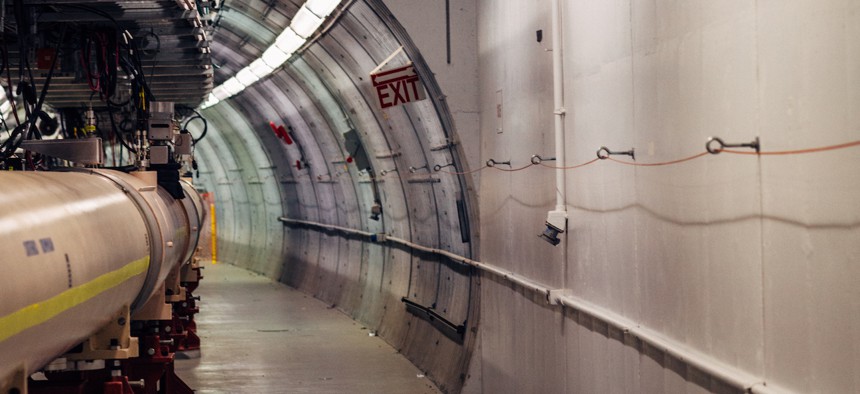
Rings of the Relativistic Heavy Ion Collider are shown here in the tunnel at Brookhaven National Laboratory on July 21, 2019. Brookhaven, located in Upton, N.Y., is among 10 of the national laboratories overseen by the Energy Department’s Office of Science Biz Herman for The Washington Post via Getty Images
National lab isn’t properly tracking sensitive and high-risk property, OIG says
A new report from the Energy Department’s inspector general found that Brookhaven National Laboratory hadn’t adequately classified crucial property, including “lasers, oscilloscopes, chemical /biological equipment … that accounted for approximately $183 million” in value.
A new report examining how a national research laboratory manages its sensitive and high-risk property has found that officials didn’t properly account for or classify their inventories for items worth a combined $258 million.
The Energy Department OIG report, published Wednesday, examined the property management program at Brookhaven National Laboratory and how it adhered to federal regulations for managing items classified for, among other things, national security or export-control considerations and their potential impact on public health and safety.
Brookhaven, located in Upton, N.Y., is among 10 of the national laboratories overseen by the Energy Department’s Office of Science and conducts research ranging from nuclear physics, climate research, quantum physics and technology, national security and other pursuits.
The 41 Code of Federal Regulations 109 requires the laboratory to maintain property management programs that classify sensitive items such as “weapons, ammunition, explosives and information technology equipment with memory capabilities” and high-risk items that include “automatic data processing equipment, export-controlled property, hazardous property and proliferation sensitive property.”
The report found that laboratory officials did not properly classify 65% of its fiscal 2021 inventory deemed sensitive by federal regulations, including IT equipment subject to export controls, worth a combined $75 million.
Officials also failed to classify 5% of its inventory determined to as export-controlled, high-risk property, including “lasers, oscilloscopes, chemical /biological equipment and centrifugal separators that accounted for approximately $183 million of the total inventory value.
The report went on to note that the export controls in the property in question are intended to prevent its by foreign countries hostile to the U.S. and that Brookhaven officials did not consistently classify high-risk materials.
“For example, we found that BNL did not identify radioactive magnets as high-risk. 41 CFR 109 requires property be correctly identified and tracked during the acquisition process and appropriately classified upon receipt,” the report said. “However, BNL did not do this at acquisition for the property mentioned above. Proper classification at acquisition of both sensitive and high-risk property is important to ensure that only authorized individuals have access to it. Unauthorized access could lead to loss, theft or misuse of technologies, technical data and information.”
The OIG said these issues occurred due to laboratory officials not fully implementing regulations governing the inventories and that they also incorrectly concluded that the regulations didn’t apply to certain items, “such as information technology equipment, communications equipment and cameras in its property policies and procedures.”
“In response to the assessment, [Brookhaven Site Office] and BNL dissented to the findings and recommendations, stating that BNL implemented Department property regulations in accordance with Department Order 580.1A (Order), Department of Energy Personal Property
Management Program,” the report said. “However, we found that the requirements lacking in BNL’s policies and procedures were substantially the same as those referenced in the Order and the underlying regulations.”
The OIG also found the laboratory’s property management guidance contradicted 41 CFR 109 requirements with regards to the frequency and accuracy of inventories, noting that the guidance “allows management discretion to plan and approach physical inventory from a cost-effective, risk-based standpoint.”
Those contradictions included polices on loaning property domestically, where the guidance allowed for loan requests in three-year increments, but 41 CFR 109 states loans can last no longer than a year with an option for one-year renewals.
The report offered three recommendations, including making Brookhaven policies consistent with 41 CFR 109 requirements, assessing the adequacy and effectiveness of its property management program and reviewing and updating its guidance.
Brookhaven Site Office concurred with the recommendations, but disputed the report, finding many of the concerns “to be inaccurate and misleading.”
While finding Brookhaven officials responsive to the recommendations, the OIG said it disagreed with the laboratory’s assessment of its findings.







